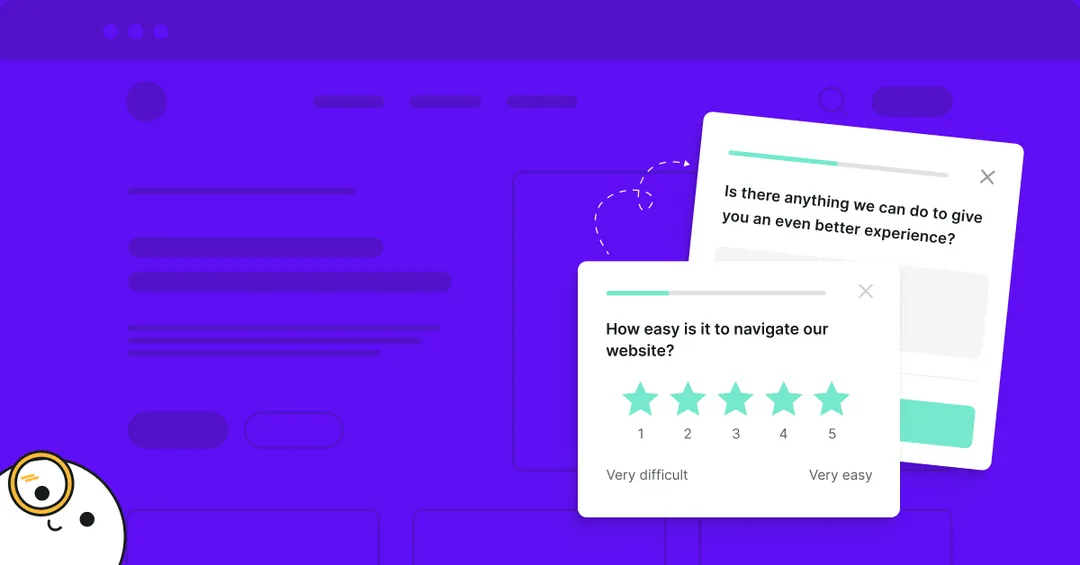Key takeaways:
- Website usability testing is a systematic evaluation from the user's perspective to assess ease of use, efficiency, and satisfaction.
- Regular usability testing helps identify user experience issues, understand user behavior, improve satisfaction, and enhance conversion rates.
- Different methods of usability testing, like moderated and unmoderated tests, A/B testing, and remote card sorting, cater to various aspects of user experience.
- Website surveys deployed directly on-site are an efficient tool for collecting user insights. With Survicate, you can try website micro surveys, usability surveys, or try AI to generate the survey you need.
- Planning for usability testing should involve defining clear objectives, identifying the target audience, and selecting appropriate testing methods.
- Preparing a conducive test environment is crucial, ensuring it replicates the user's natural setting as closely as possible.
- Analyzing usability test data requires scrutinizing user behavior patterns and feedback to identify and categorize usability problems.
- Recommendations for website improvements should be prioritized and justified with test data, with a suggested timeline for implementation.
- Utilizing usability testing tools like heatmaps, screen recording, and accessibility checkers can provide additional insights into user behavior and website accessibility.
Ever feel like your website might be the digital equivalent of a maze? You're not alone.
Website usability testing is your map out of the labyrinth, ensuring visitors easily find their way. This article is a must-read for anyone who's ever wondered why users leave their site, struggle to complete a purchase, or just don't click where they're supposed to. We'll dive into the nitty-gritty of usability testing—what it is, why it's crucial, and how to do it effectively. Plus, stick around for a handy checklist to guide you through your usability testing adventure.
By the end, you'll be equipped to enhance your site's user experience, keeping visitors happy and coming back for more.

Fundamentals of website usability testing
The efficacy of your online presence hinges on how well users can navigate and engage with your website, making usability testing an essential practice.
What is usability testing?
Website usability testing is the systematic evaluation of your website from the end user's perspective. It assesses ease of use, efficiency, and overall satisfaction provided by the website. The significance of usability testing lies in its capacity to unveil user's perspective and roadblocks, ensuring your website fulfills its intended purpose effectively.
Why you should perform website usability testing regularly
Identify and Resolve Usability Issues: One of the core goals of website usability testing is to identify any hitches in the user experience. By catching these snags, you can rectify problems before they affect a larger audience.
Understand User Behavior: Usability testing grants insight into how users interact with your website. Are they finding what they need efficiently? This understanding lets you tailor your website to user preferences and expectations.
- Improving User Satisfaction: A seamless user interface coupled with intuitive navigation ensures a positive experience for the visitor, fostering loyalty and encouraging repeat visits.
- Enhancing Conversion Rates: By streamlining user paths to action, your website becomes a more effective tool for converting visitors into customers or followers.
Types of usability tests
Website usability testing aims to identify any issues, collect qualitative and quantitative data, and determine the participant's satisfaction. Typically, during a test, participants will try to complete typical tasks while observers watch, listen, and take notes. Different methods cater to various aspects of user experience and can be selected based on the specific goals of the testing session.
Moderated usability testing
This traditional approach involves a moderator who guides the participant through the test, providing instructions and asking questions to gain insights into the user's thought process. Moderated tests can occur in person, in a controlled environment, or remotely, using screen-sharing and communication tools. The presence of a moderator allows for immediate probing and clarification of user behaviors and responses.
Unmoderated usability testing
Unmoderated tests are conducted without a moderator present, allowing participants to complete tasks at their own pace. This method is often more scalable and cost-effective, as it can be administered to many users simultaneously through online platforms. Unmoderated testing is useful for gathering data on how users interact with a website in a more naturalistic setting.
A/B Testing
A/B testing, also known as split testing, involves comparing two web page versions to see which one performs better. Users are randomly served either version A or version B, and their interaction with each is measured against predetermined metrics like conversion rates or time on the page. This quantitative method is powerful for making data-driven decisions about specific elements of a website.
Online Surveys
Online surveys efficiently collect user feedback on a website's usability by asking targeted questions post-interaction. They offer a mix of quantitative and qualitative research and can reach a broad audience quickly and cost-effectively.
Surveys must be clear and unbiased to yield actionable insights and are most effective when users' experiences are recent. This method complements observational testing by providing a broader view of user satisfaction and behavior patterns.
Remote Card Sorting
Remote card sorting is a method used to understand how users categorize information, helping to inform the structure of a website's content and navigation. Participants organize topics into groups that make sense to them, which can be done remotely using specialized software. This method provides valuable insights into the user's mental model and can be conducted without the need for face-to-face interaction.
Guerrilla testing
Guerilla testing is a quick and low-cost method where testers approach people in public places, such as coffee shops or libraries, to ask them to use a website for a short period. The goal is to collect immediate feedback on a design or functionality from the perspective of real-world users. This method is best for gaining high-level insights rather than in-depth analysis.
By incorporating website usability testing into the development process, you can identify potential issues early on, saving time and resources in the long run. More importantly, it helps create a user-friendly website that meets the needs and expectations of your audience, ultimately enhancing the overall user experience and increasing user satisfaction and engagement.
Planning a website usability test
Effective usability testing begins with meticulous planning to ensure actionable insights. The following steps are critical.
Defining objectives
Before you conduct usability testing, clearly define what you aim to achieve. This could include specific tasks you want users to complete successfully or general areas such as improving navigation or checkout processes.
Set clear, measurable goals; this will drive the entire testing process.
Identifying target audience
Knowing who your users are is crucial. Identify characteristics such as their age, technical proficiency, and familiarity with your product. This allows you to select participants who best represent your actual user base, ensuring that the results of the website usability test are relevant.
Selecting appropriate usability testing methods
Choose usability testing methods that align with your goals and target user profile. Each of them offers unique benefits and can be chosen based on the specific needs of the website, the stage of development, and the resources available.
When selecting a usability testing method, consider the nature of the feedback you need, whether qualitative insights or quantitative data are more valuable for your objectives, and how the test results will inform the design decisions for your website.
It's important to note that no single method will capture the full spectrum of user experience issues. Therefore, employing a combination of different usability testing methods across various stages of the website's development is often beneficial.
Executing website usability testing
Effective execution of usability testing hinges on methodical preparation, execution, and data collection. Each step is critical in uncovering design issues that could impact user satisfaction and overall functionality.
Preparing test environment
Before conducting usability tests, ensure that your test environment is conducive to capturing accurate user interactions. It should replicate the user's natural setting as closely as possible.
Begin by setting clear objectives for your testing and selecting the appropriate tasks you want participants to perform. Prepare all necessary equipment and ensure the software or website functions correctly.
Lastly, confirm that recording tools are operational to document the session accurately.
Conducting tests
During the testing, you will guide participants through predetermined tasks while observing their behavior and taking notes on their performance. Use various testing methods, such as moderated sessions, online surveys, and A/B testing, to gather comprehensive information about your website's usability.
Moderated testing provides real-time insights, whereas online surveys help to collect feedback from a larger audience quickly. Participants must represent your target audience accurately to obtain meaningful results.
Capturing data
The final step in usability testing is the effective data capture and analysis. Utilize qualitative data, such as participant feedback and comments, and numerical data, including completion rates and time on task.
Data should be organized to make it easy to identify patterns and draw conclusions. Consider using spreadsheets or specialized feedback management software to help with data collation and analysis. Remember to highlight key findings that could lead to actionable improvements in usability.
Analyzing and reporting results
After conducting website usability tests, you'll gather significant data, which must be interpreted accurately to enhance your website's performance. Your ability to analyze and report this data clearly will direct the course of action to optimize user experience.
Interpreting data
Interpreting the data from usability tests involves scrutinizing user behavior patterns and feedback to identify usability issues. You'll want to categorize these findings by severity and frequency. Use bold for severe issues that impede user tasks, italicize those less critical but worth noting, and use regular font for minor concerns. For example:
- Major: Users cannot complete the checkout process.
- Minor: Some users find the navigation menu confusing.
Quantitative data such as task completion rates, time on task, and error rates provide objective usability measures.
Creating website usability reports
For your usability report, structure is vital. Begin with a summary of the test objectives and methodology, followed by the main findings. Use tables to organize the quantitative data and bullet points to list key qualitative insights. Here's a basic outline:
- Test Overview: Brief description, objectives, and methodology.
- Key Findings:
- Quantitative metrics (use tables).
- Qualitative observations (use bullet points).
Link to a well-structured usability testing report for visual and organizational guidance.
Recommending actions
Once you've reported the usability test results, offer concrete recommendations for improvement. Categorize the actions based on priority and include a suggested timeline for implementation.
- High Priority: Fix the checkout bug by the end of Q2.
- Medium Priority: Simplify the navigation menu structure by Q3.
Justify each action with evidence from the data to ensure stakeholders understand each recommendation's need—review strategies for analyzing and reporting usability test results for more guidance on prioritizing actions.
Usability testing tools
Usability testing tools are crucial in enhancing user experience by identifying potential website improvements. Here are some categories and tools that you should consider:
Automated testing tools
Automated testing tools can quickly gather data on usability by simulating user interactions.
- Heatmaps and screen recording: Tools like FullStory offer visual representations of where users click, move, and scroll on your site, providing insights into user behavior.
- Accessibility Checkers: These programs assess whether your website is accessible to all users, including those with disabilities.
Survey software
Online surveys can serve as an efficient way to collect user insights. They can pop up directly on your website at targeted places or times. This way, you can gather feedback on your website user experience and ask other survey questions about your site.

12-step website usability testing checklist
A usability testing guide is essential for verifying that your website offers users a seamless and enjoyable experience. Below is a detailed guide that encapsulates the key components of website usability:
1. Purpose and navigation clarity
- Ensure visibility and easy access to the site's navigation menu.
- Employ explicit, meaningful labels for navigation elements.
- Implement a search feature when necessary.
2. Adaptive design
- Tailor the site for various devices and displays (including desktops, smartphones, and tablets).
- Make sure the site's design fluidly adapts to various screen dimensions.
3. Speed optimization
- Compress images and media files to enhance loading times.
- Reduce the number of HTTP requests and activate browser caching.
- Utilize CDNs to distribute content more rapidly.
4. Design consistency and brand identity
- Keep a uniform design motif across the site.
- Apply steady color schemes, typographies, and design elements.
- Uniformly integrate branding components like logos and slogans.
5. Content clarity and legibility
- Write in a straightforward, concise manner.
- Organize content into digestible blocks with clear headings.
- Choose fonts that are easy to read and size them appropriately.
6. Strategic use of space
- Use ample white space around elements to boost readability and reduce visual chaos.
- Refrain from overloading pages with excessive content or imagery.
7. Inclusivity and accessibility
- Make the site usable for individuals with disabilities.
- Adhere to WCAG to ensure the site is perceivable, usable, understandable, and stable.
8. Browser interoperability
- Verify the site's performance and look across various web browsers (like Chrome, Firefox, Safari, Edge).
9. Effective error communication
- Present explicit, instructive error notifications to assist users in troubleshooting.
- Indicate errors in form fields and offer constructive guidance.
10. Mobile optimization
- Employ responsive design strategies to enhance the mobile site experience.
- Guarantee that elements are optimized for touch interaction and that font sizes are suitable for mobile viewing.
11. Actionable CTA implementation
- Incorporate noticeable CTAs that direct users towards intended actions.
- Design buttons and links to be visually striking and easy to recognize.
12. User engagement and evaluation
- Perform usability evaluations with actual users to pinpoint and rectify usability concerns.
- Gather user feedback and use it as a basis for ongoing site enhancement
Get real user insights with Survicate
Effective engagement with your audience is essential for understanding and meeting their needs. A comprehensive approach to gathering and analyzing user insights is crucial for any business aiming to enhance its website and services. This is where a tool like Survicate becomes invaluable. It helps identify website areas that may require improvement or refine the overall user journey.
With Survicate's actionable insights, you can make strategic changes that significantly elevate your online user experience. If you want to improve their digital interface, start Survicate's 10-day free trial of the Business Plan, ensuring their website meets and exceeds user expectations.








.webp)






.svg)

.svg)



